Locate the very best Tailor Perth: Premium Tailoring for Distinctive Design
Locate the very best Tailor Perth: Premium Tailoring for Distinctive Design
Blog Article
Understanding the Tailoring Refine: From Fabric Selection to Final Suitable for the Perfect Closet
The tailoring process is an intricate interaction of art and science, starting with the vital decision of fabric selection and culminating in the specific modifications of final fittings. Each fabric kind brings distinct top qualities that influence not just the aesthetic appeal yet also the garment's long life and suitability for different occasions.
Value of Fabric Choice
Selecting the right material is critical in the tailoring process, as it straight influences the comfort, longevity, and overall aesthetic of the final garment (tailor perth). The choice of fabric sets the foundation for the garment's efficiency, capability, and style. Different materials possess distinct residential properties, such as stretch, weight, and breathability, which can dramatically influence just how the garment drapes and fits the body
Moreover, material choice impacts the garment's longevity and ease of care. High-grade fabrics can withstand wear and tear, keeping their look and framework with time, while lower-quality products might cause pilling or fading. Furthermore, the ideal material adds to the garment's capacity to shift across seasons and celebrations, therefore boosting convenience.
A customized piece made from a suitable fabric not only showcases workmanship however also elevates the user's self-confidence. As a result, understanding the subtleties of material choice is critical for any customizing venture. It makes sure that the end product not just meets the visual wishes of the client but also straightens with useful needs, thereby accomplishing a harmonious equilibrium in between type and feature in the tailored closet.
Types of Fabrics and Their Usages
Understanding the various sorts of materials available is essential for making notified choices during the tailoring process. Each textile possesses special qualities that dictate its suitability for certain garments and occasions.
Its convenience allows it to be customized right into everything from shirts to gowns. Its all-natural elasticity helps garments preserve shape over time.
Silk shows luxury and is lightweight, making it best for eveningwear and delicate blouses; however, it requires careful handling because of its fragility. Bed linen, with its distinctive surface, is a preferred selection for cozy climates, supplying a crisp and ventilated feeling, but it wrinkles easily, which may affect the garment's appearance.
Synthetic fabrics, such as polyester and nylon, offer resilience and resistance to wrinkles, making them suitable for daily wear and active garments. Recognizing these textile kinds and their residential or commercial properties enables far better decision-making, ensuring that each tailored item not just fits well however likewise straightens with the desired function and event.
The Tailoring Techniques Explained
The art of tailoring depends on a variety of techniques that transform fabric right into well-fitted garments. Central to this process is pattern drafting, where a tailor develops themes based on the client's measurements and desired design. This preliminary step ensures that the garment will certainly fit the wearer correctly before any kind of cutting occurs.
As my site soon as patterns are developed, cutting techniques enter into play. Precision is paramount as errors can bring about misfitting garments. Tailors usually use various reducing techniques, such as single-layer reducing for elaborate designs and multiple-layer cutting for effectiveness on conventional patterns.
Basting is another essential strategy, enabling dressmakers to briefly sew material assemble for an initial fitting. This technique offers the possibility to analyze the drape and general shape before last stitching.
Seaming methods, including french joints and flat-felled seams, improve the garment's sturdiness and aesthetic allure. Tailors likewise use techniques such as interfacing and cushioning to provide framework and shape to certain locations, like collars and shoulders.
Last but not wikipedia reference least, finishing methods, including hemming and edge completing, make certain the garment's longevity while supplying a polished look. With each other, these techniques form the backbone of reliable tailoring, causing charming, custom-fit garments.
Fitting Modifications and Considerations

Key factors to consider include the shoulder fit, which ought to neither droop neither restrict movement, and the sleeve size, which must permit for comfy arm movement while maintaining a sleek appearance. Furthermore, modifications at the midsection can fine-tune the silhouette, with options to allow out or absorb material as needed.
The surge of pants is another crucial variable; it must rest conveniently over the hips without triggering discomfort, permitting for simplicity of movement. Hemming lengths for both trousers and skirts should show the wearer's recommended style while respecting percentages.

Preserving Your Tailored Clothing
Constantly comply with the treatment label directions, which may recommend completely dry cleaning for delicate textiles or equipment cleaning for even more resilient materials. Prevent constant laundering, as this can put on down the material and change the garment's shape.
Storage space is just as important; usage cushioned wall mounts for layers and coats to preserve shoulder structure, and store pants folded neatly or hung to stop creasing. Shield garments from straight sunshine, which can fade colors and damages fibers.
Furthermore, periodic inspections for minor fixings can protect against larger issues. Look for loose switches, tearing joints, or their explanation signs of moth damages, attending to these problems promptly to preserve the garment's integrity.
Last but not least, take into consideration seasonal turning. Putting on tailored items in moderation permits materials to recuperate, prolonging their life-span. By implementing these maintenance strategies, you can make certain that your customized garments remain as immaculate as the day you initially wore them, boosting your optimal closet for years to come.
Final Thought
The tailoring procedure, encompassing material selection, experienced strategies, and accurate suitable changes, plays an important role in creating garments that boost both comfort and design. Each stage adds to the total effectiveness of the end product, making sure that clothes not only fits well yet also reflects private identity. Recognizing the importance of upkeep extends the life of tailored garments, solidifying their value in a well-curated wardrobe. A comprehensive method to tailoring finishes in a confident and refined look.
Picking the appropriate textile is critical in the customizing procedure, as it directly influences the comfort, sturdiness, and general aesthetic of the final garment. The selection of fabric sets the structure for the garment's efficiency, capability, and design. Different textiles have special properties, such as weight, stretch, and breathability, which can significantly influence exactly how the garment drapes and fits the body.
The art of tailoring depends on a range of methods that transform material into well-fitted garments.The tailoring procedure, incorporating fabric option, knowledgeable methods, and precise suitable modifications, plays a vital role in developing garments that improve both convenience and style.
Report this page